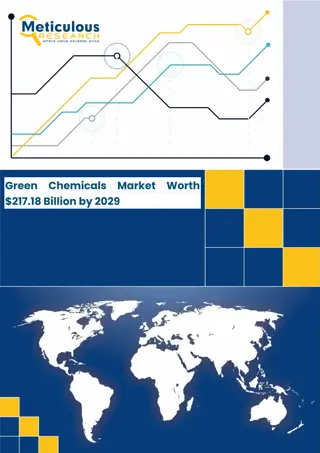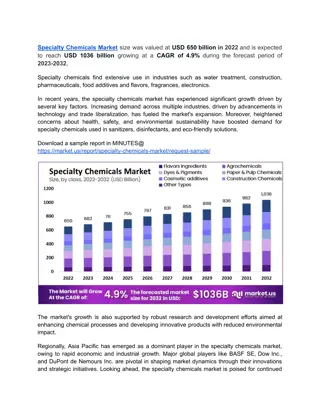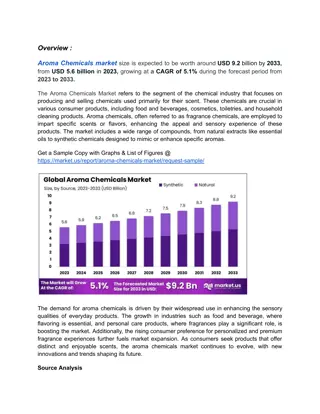Green Chemistry Chemicals Market Size Report, 2022-2029
The green chemicals market is expected to reach $217.18 billion by 2029 at a CAGR of 11.6% from 2022 to 2029. The growth of this market is driven by the scarcity of non-renewable resources, growing awareness regarding sustainable products, rising government initiatives to promote the use of green ch
2 views • 4 slides
Understanding NHANES Data for Environmental Exposure Studies
National Health and Nutrition Examination Survey (NHANES) is a crucial population-based survey in the U.S. that collects data on health and nutritional status. This data supports various applications, including assessing human exposure to environmental chemicals. NHANES conducts biomonitoring to qua
5 views • 27 slides
North America Crop Protection Chemicals Market
North America Crop Protection Chemicals Market by Type (Synthetic [Herbicides, Insecticides], Biological [Bioinsecticides, Bioherbicides]), Formulation (Liquid, Dry), Mode of Application (Seed Treatment, Soil Treatment), Crop Type - Forecast to 2030\n
7 views • 4 slides
Overview of Heavy Chemicals Manufacturing Process
The field of industrial chemistry involves the large-scale preparation of heavy chemicals, which are chemicals produced and used commercially. This process requires an understanding of various physico-chemical principles and specific manufacturing techniques for chemicals like Ammonia, Sulphuric Aci
1 views • 30 slides
Green Chemicals Market Worth $217.18 Billion by 2029
The Green Chemicals Market is expected to reach a value of $217.18 billion by 2029, at a CAGR of 11.6% during the forecast period 2022\u20132029.\n
1 views • 4 slides
Agrochemicals Market to be Worth $338.49 Billion by 2030
Agrochemicals Market by Type (Fertilizers, Synthetic Chemicals, Biological Chemicals, Biostimulants, Plant Growth Regulators), Form (Dry, Liquid), Mode of Application (Seed Treatment, Soil Treatment, Fertigation), Crop Type - Global Forecast to 2030\n
0 views • 4 slides
Green Chemicals Market Worth $217.18 Billion by 2029
The Green Chemicals Market is expected to reach a value of $217.18 billion by 2029, at a CAGR of 11.6% during the forecast period 2022\u20132029.\n
0 views • 4 slides
Green Chemicals Market Worth $217.18 Billion by 2029
The Green Chemicals Market is expected to reach a value of $217.18 billion by 2029, at a CAGR of 11.6% during the forecast period 2022\u20132029.\n
1 views • 4 slides
Streamlining Chemical Inventory Management with UC Chemicals
This project plan focuses on transitioning existing chemical inventories into UC Chemicals system to address challenges with outdated information and database discrepancies. The UC Chemicals application offers real-time updates, assists first responders, and simplifies inventory reconciliation using
0 views • 21 slides
Key Innovations in Specialty Chemicals for the Textile Industry
Specialty Chemicals Market By Class (Flavors Ingredients, Agrochemicals, and Other Types), By End User Industry (Automobile, Agriculture, and Other Industries), By Region and Companies - Industry Segment Outlook, Market Assessment, Competition Scenario, Trends, and Forecast 2023-2032
0 views • 4 slides
Competitiveness in the Water Treatment Chemicals Market
Water Treatment Chemicals Market By Product Type (Coagulants and Flocculants, Biocide and Disinfectant, pH, and Other product types), By End-Use (Power, Oil & Gas, Chemical Manufacturing, and Other End-Uses) and by Region and Companies Industry Segme
0 views • 4 slides
Agrochemicals Market to be Worth $338.49 Billion by 2030
Agrochemicals Market by Type (Fertilizers, Synthetic Chemicals, Biological Chemicals, Biostimulants, Plant Growth Regulators), Form (Dry, Liquid), Mode of Application (Seed Treatment, Soil Treatment, Fertigation), Crop Type - Global Forecast to 2030\
0 views • 8 slides
Understanding Photosensitization in Animals - Causes and Types
Photosensitization in animals is the activation of photodynamic chemicals on the skin by UV or visible light, leading to cellular damage and inflammation. Factors necessary for photosensitization include oxygen, sunlight, specific chemicals, and skin lacking pigments. Types of photosensitization inc
1 views • 8 slides
Beautiful Stained Glass Designs to Enhance Your Home
The hollanderfusingcenter.com provides an extensive array of chemicals and fusing supplies of the utmost quality. Elevate your art with our extensive selection and exceptional customer service.\n\n\/\/hollanderfusingcenter.com\/collections\/chemicals
3 views • 1 slides
Aroma Chemicals Market Expected to Soar with Surge in Organic and Natural Produc
Aroma Chemicals Market; By Source(Synthetic, Natural, Natural-Identical), By Products(Benzenoids, Terpenes and Terpenoids, Musk Chemicals, Others) (Ketones, Esters, Aldehydes), Application, Flavors, Convenience Foods, Confectionery, Dairy Products, B
0 views • 4 slides
Chemical Distribution Market Sees Growth Surge Driven by Demand and Technologica
Chemical Distribution Market By Product (Specialty Chemicals and Commodity Chemicals), By End-Use (Automotive & Transport, Agriculture, Construction, Consumer Goods, Industrial Manufacturing), By Region and Companies - Industry Segment Outlook, Marke
0 views • 4 slides
Sanjivani Agencies - Supplier of Retail Pharma Chemicals in Hyderabad
Established in 2019, Sanjivani Agencies is a leading supplier and trader of Retail Pharma Chemicals in Hyderabad. They offer a wide range of products including animal feed, laboratory chemicals, glassware, plastic ware, and more. Committed to quality and customer satisfaction, Sanjivani Agencies aim
0 views • 7 slides
Geomechanical Effects of Oilfield Chemicals on Sand Failure in Reservoir Rocks
This study by Elizabeth O. Wuyep et al. explores the geomechanical effects of oilfield chemicals on sand failure in reservoir rocks. It discusses the role of oilfield chemicals, limitations of previous works, experimental flow chart, and static saturation tests. The research emphasizes the need for
0 views • 25 slides
Essential Science Lab Equipment Overview
Explore a range of essential science lab equipment including a Triple Beam Balance for measuring mass, Goggles for eye protection, Mortar and Pestle for crushing and mixing substances, Bunsen Burner for heating and sterilization, Beaker for liquids, Test Tube Clamp for handling test tubes, Test Tube
0 views • 23 slides
Global Textile Chemicals for Technical Textiles Market
Global Textile Chemicals for Technical Textiles Market
0 views • 7 slides
Insights into Specialty Chemicals Industry: Perstorp Plantwide Control
Explore the intricacies of specialty chemicals plants through the lens of Perstorp's experience, covering topics such as control objectives, degrees of freedom, and characteristics of these complex facilities. Discover the unique challenges and considerations in controlling processes for specialty c
0 views • 38 slides
Chemical Addition in Drinking Water Treatment Plant Certification Training
Learn about the essential topics of chemical addition in water treatment, including the types of chemicals used, safety measures, dosage calculations, and feed systems. Explore the importance of coagulating chemicals and their role in promoting particle aggregation for effective water treatment. Dis
0 views • 133 slides
Agrochemicals market
Agrochemicals t by Type (Fertilizers, Synthetic Chemicals, Biological Chemicals, Biostimulants, Plant Growth Regulators), Form (Dry, Liquid), Mode of Application (Seed Treatment, Soil Treatment, Fertigation), Crop Type - Global Forecast to 2030\n
1 views • 4 slides
Food Grade Chemical Handling Safety Information
Handling food-grade chemicals for flavor preparation requires minimal risk with proper precautions. The chemicals include 2,3-Pentanedione and Vanillin, commonly used in food products. Safety measures such as using a fume cupboard, wearing PPE, and proper disposal methods are recommended to ensure s
0 views • 7 slides
GEF Chemicals Management Overview & Strategies
GEF plays a crucial role in managing chemicals such as Persistent Organic Pollutants (POPs), Ozone Depletion Substances, and Mercury. With a total allocation of $425 million, GEF agencies work towards reducing POPs use, updating National Implementation Plans, and supporting countries in meeting obli
0 views • 11 slides
Evolution of Sukhjit Starch & Chemicals Ltd - Investor Presentation 2015
Sukhjit Starch & Chemicals Ltd, a leading producer in India, highlights its business overview, product overview, management vision, industry dynamics, financial highlights, and strategic outlook in the investor presentation. With a history of consistent growth and strong management, the company has
0 views • 25 slides
Lipophilicity and Translocation of Chemicals in Plants: Exploring the Relationship Between Log.D and TSCF
A study investigates the correlation between the lipophilicity of chemicals and their translocation in intact plants. The focus is on the relationship between log.D values and the Transpiration Stream Concentration Factor (TSCF). Various curves are proposed to describe this relationship, aiming to r
0 views • 9 slides
Global Water Treatment Chemicals Market
The Global Water Treatment Chemicals Market Size is expected to reach USD 42.33 Billion by 2030, at a CAGR of 4.4% during the forecast period 2022 to 2030.\n\n
0 views • 7 slides
Laboratory Safety Regulations and Guidelines for Chemistry Students
Strict safety measures have been enforced in the chemistry department at UCLA due to recent accidents, leading to the introduction of new safety rules for handling chemicals. This includes bans on certain solvents, implementation of PPE requirements, and adherence to a specific dress code. The empha
0 views • 8 slides
hydrogen market
The chemicals industry is critical to accelerating the shift toward a low-carbon and circular economy; however, it faces the significant challenge of achieving net-zero emissions. The chemicals industry needs solutions such as hydrogen, carbon captur
1 views • 3 slides
Understanding GHS: The Globally Harmonized System of Classification and Labeling of Chemicals
The Globally Harmonized System (GHS) is a standardized approach to classifying and labeling chemicals, offering workers the right to understand hazards. It enhances cross-border communication, reduces confusion, and ensures consistent information. Major changes in GHS labels and Safety Data Sheets i
0 views • 17 slides
Global Harmonized System of Classification and Labeling of Chemicals (GHS) Overview
The Global Harmonized System of Classification and Labeling of Chemicals (GHS) was developed to address the inconsistencies in hazard information for chemicals globally due to significant trade. The history, mandate, and provisions of GHS, along with additional domestic harmonization efforts, are di
0 views • 29 slides
Building a Comprehensive Chemical Inventory System
Conduct a thorough review of all processes to identify and document all chemicals used on-site, create a standardized inventory with relevant information, and use the inventory to prioritize hazardous chemicals for substitution, track usage quantities, and streamline purchasing practices to prevent
0 views • 7 slides
Regulation of Chemicals in Children's Products for Safety
Massive safety concerns arose in 2007 due to high lead levels in toys, leading to legislation like the Children's Safe Product Act in WA. The Act restricted lead, cadmium, and phthalates in children's products, with a focus on Chemicals of High Concern to Children (CHCCs). The implementation involve
0 views • 27 slides
Agricultural and Veterinary Chemicals Regulation in Australia - Overview
The regulation of agricultural and veterinary chemicals in Australia is overseen by the Australian Pesticides and Veterinary Medicines Authority (APVMA), established in 1993. The APVMA is responsible for assessing and registering pesticides and veterinary medicines to ensure their safety and effecti
0 views • 15 slides
Recognizing Laboratory Hazards: Physical Hazards and Corrosive Chemicals
Laboratory hazards, particularly physical hazards and corrosive chemicals, pose risks to individuals working in laboratory settings. Corrosives, such as acids, bases, oxidizing agents, and gases, can cause significant harm to eyes and skin. Proper precautions and handling procedures are crucial to m
0 views • 16 slides
Sustainable Management of Wastewater Chemicals in Jamaica
Wastewater management in Jamaica poses risks due to the use of chemicals that can harm public health and the environment. Proper treatment and disposal of wastewater chemicals are crucial to prevent long-term negative impacts. Addressing this issue requires a policy framework for sound chemical mana
0 views • 10 slides
Safely Heating Chemicals with a Bunsen Burner
Learn how to safely heat chemicals using a Bunsen burner through a series of activities including safety precautions, thermal decomposition of copper carbonate, hazard symbol interpretation, and a practical demonstration with step-by-step instructions. Diagrams and explanations provided to enhance u
0 views • 8 slides
Water Contamination and Human Health: Causes, Types, and Examples
Water contamination poses a significant risk to human health, caused by various pollutants such as microorganisms, chemicals, industrial wastes, and sewage. Common sources include human and animal sewage, industrial emissions, pesticides, and agricultural runoff. Different types of contaminants incl
0 views • 25 slides
Everything You Should Know About Chemical and Acid Resistant Heat Transfer Labels
Chemical resistant heat transfer labels are capable of withstanding direct contact with harsh chemicals. Coated with permanent adhesive that resists solvents and chemicals, they remain permanently adherent even when exposed to harsh chemicals and dur
0 views • 6 slides







































